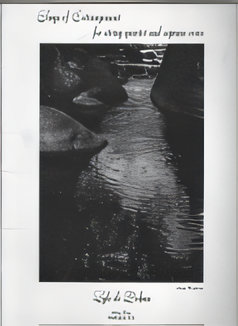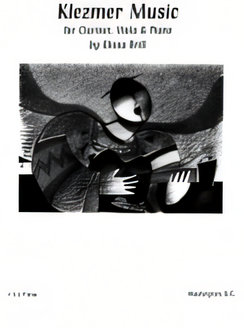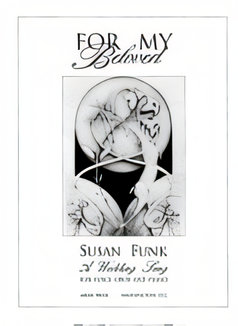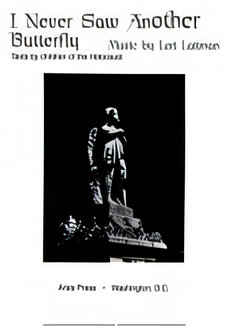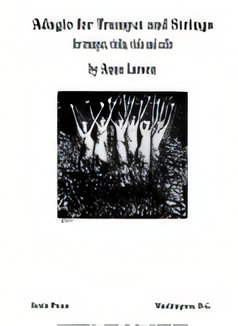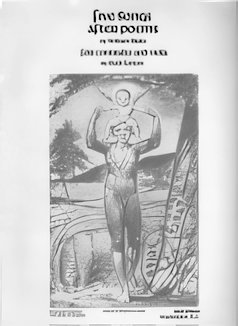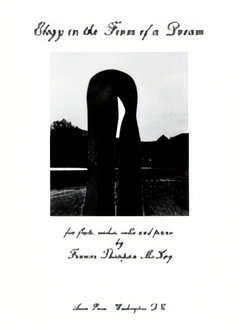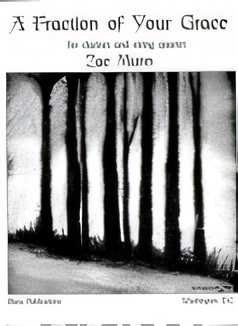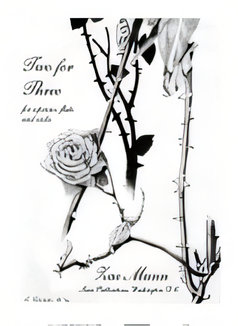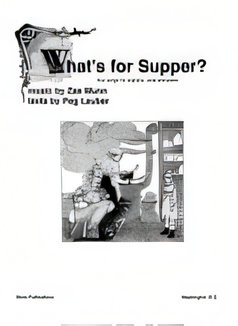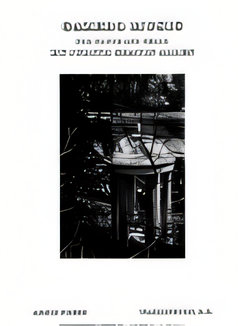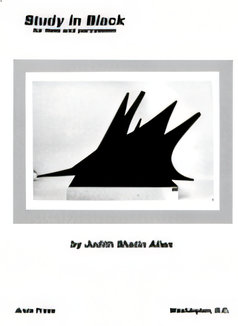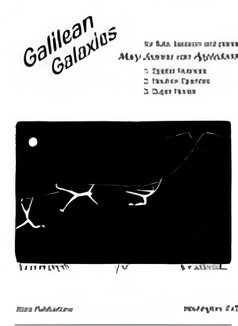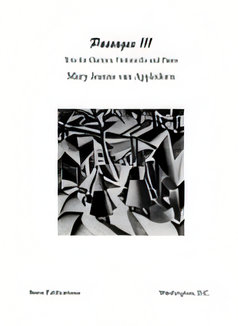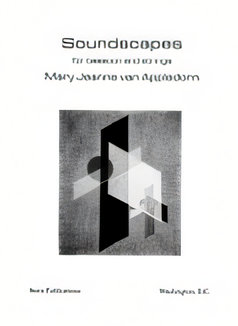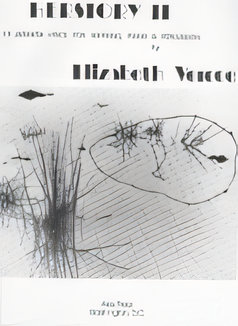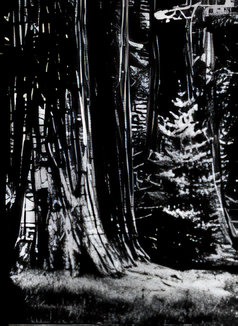Mixed Ensembles
Bohun, Lyle de
Songs of Estrangement for String Quartet & Soprano
The four songs are entitled: Snow Has Lain, Flowers Fall, Death Has Risen and Love Is A-Borning. With metaphors from nature, this four movement work dramatically depicts the developing intensities of a romantic relationship which over time matures and stabilizes into mutual contentment.
The music circulates at the New York Public Library.
Brill, Elissa
Klezmer Music for Clarinet, Viola and Piano
“Klezmer Music for clarinet, viola and piano expresses the joy and spontaneity of the Yiddish folk music that inspired it.” (Elissa Brill)
The composer writes: “In Hebrew, k’lai zemer means musical instruments. In the European Jewish tradition, the Yiddish term “Klezmer” came to denote both a certain type of traveling musician, and the band in which he played. The word is also used to describe the characteristic music these bands performed. Klezmer bands were standard entertainment at weddings and other social events in both Jewish and non-Jewish circles. Klezmer Music is not a Klezmer piece per se, although much of its structure stems from this Yiddish folk form.”
The music circulates at the New York Public Library.
Funk, Susan
For My Beloved
A technically easy piece for weddings or recitals, this song was the composer’s gift to her bridegroom. The text is from the Song of Solomon.Laitman, Lori
I Never Saw Another Butterfly
Six songs for soprano and alto saxophone or clarinet or bassoon on texts by children of the Holocaust.
Based on poetry by children from the Terezin concentration camp and written in 1996, the six songs of the cycle use varied imagery and musical styles. The composer writes: “One cannot help but be touched by the hope and innocence that these children put into their poetry, despite their terrible surroundings. The accompaniment of saxophone is intended to be haunting and soulful, with echoes of Klezmer music. The song titles are: The Butterfly, Yes–That’s the Way Things Are, Birdsong, Man Proposes, God Disposes, and The Old House . The first performance was at John Hopkins University in 1996 with soprano Lauren Wagner and saxophonist Gary Louie, for whom the piece was written.
The music is available from the composer’s website and also circulates at the New York Public Library.
Larson, Anna
Adagio for Trumpet and Strings
Six songs for soprano and alto saxophone or clarinet or bassoon on texts by children of the Holocaust.
Based on poetry by children from the Terezin concentration camp and written in 1996, the six songs of the cycle use varied imagery and musical styles. The composer writes: “One cannot help but be touched by the hope and innocence that these children put into their poetry, despite their terrible surroundings. The accompaniment of saxophone is intended to be haunting and soulful, with echoes of Klezmer music. The song titles are: The Butterfly, Yes–That’s the Way Things Are, Birdsong, Man Proposes, God Disposes, and The Old House . The first performance was at John Hopkins University in 1996 with soprano Lauren Wagner and saxophonist Gary Louie, for whom the piece was written.
The music is available from the composer’s website.
Lomon, Ruth
Five Songs after Poems by William Blake
The first four poems by William Blake set here are from his Songs of Experience and the fifth is from his Satiric Verses and Epigrams. The pieces are polyphonic duets with the titles: The Sunflower, The Fly, The Sick Rose, The Clod and the Pebble, and Injunction. In a paper entitled A Comparative Stylistic Analysis, Carol Ann O’Connor writes: “This set of five polyphonic duets for contralto and viola incorporates many aspects of musical personality and technique found in [the composer’s] later works…and illustrate Lomon’s sensitivity to capturing in music the essence of a poetic gesture.
The score circulates at the New York Public Library.
McKay, Francis Thompson
Elegy in the Form of a Dream
“soul-shattering” (The Cape Codder)
“dropped like a plumb line into the emotional depths of awareness” (The Washington Post)
The piece was completed in 1986, initiated by the death of a close friend of the composer, writer John Edward Hill. The music deals with the relationship between the external world, in which death is final, and the internal world, which transcends the limits of death and time. The tension and opposition between these two worlds is the subject of this composition. Dika Newlin describes the piece in the Richmond Times-Dispatch as follows:
“…expressionistic fantasy music, filled with strange rappings, thrumming inside the piano, [and] all manner of unexpected sounds designed to stimulate the imagination of the listener.”
The score is available on Amazon.
Munn, Zae
A Fraction of Your Grace for clarinet and string quartet
Written for David Liptak in 1997, the piece was inspired by the grace with which he faced the impending death of his wife. There is an alternation of sections based on quartal chords and sections based on open fifths. Motives derived from the quartal and quintal structures provide most of the melodic material.
In the Maze of the Moment for horn and string quartet
Two for Three
Two for Three (1994) is based on two poems by Peg Carlson Lauber: For a Few Minutes Lie in the Sun and Contemplate Cliché Angels. The structure of the first song puts musical parentheses around anger and bitterness by alternating serenity, venomous emotions and a return of serenity. The second song alternates humorous music with clearly derivative jazz. The two songs may be performed separately.What’s for Supper?
Composed both to entertain and educate young people about contemporary concert music as well as serve as recital pieces, What’s for Supper? was written on a COSTAR Grant from Saint Mary’s College. The titles of the four songs are: I’ll Go Along, What’s for Supper?, If I Could, and Oh no! Not Me.
Ross, Elaine M.
The Distant Light
Written in 2003, the music is in one movement and is dedicated to Jerry and Erica Peel.
The score is available from the composer’s website.
Shatin, Judith
Gazebo Music for Flute and Cello
“delicate, understated writing” (Richmond Times-Dispatch)
“Judith Shatin’s Gazebo Music (1981) for flute and cello was composed for a dance in which the dancers came through the woods up to the gazebo and then glided away. The arch form and flowing music fit perfectly: soft chords, pastorale, a waltz-like center section, pastorale, soft chords.” (Richmond Times-Dispatch)
The score is available from the composer’s website.
Study in Black for Flute and Percussion
Study in Black was composed at the American Dance Festival at Duke University in 1981. The piece uses restrained gestures and a nuanced starkness that sporadically unleash flashes of energy until the final frenzied explosion and decay of the ending. The title reflects the choreographic suicide ritual created by Marguerite Fishman, as well as the linear design and emotional thrust that together shaped the composer’s intent.
The score is available from the composer’s website.
Van Appledorn, Mary Jeanne
Five Psalms for trumpet, tenor voice and piano
Written in 1998 and based on Psalms 100, 13, 117, 23 and 150.Galilean Galaxies for Flute, Bassoon, and Piano
Galilean Galaxies was written in 2000. There are three movements: Spatial Nuances, Neutron Sparkles, and Super Novae.
Passages III for Clarinet, Cello and Piano
Passages III is a trio for clarinet, cello and piano that was commissioned in 2003 by Trio Montecino. The piece continues the composer’s concept of creating movements based on the colors of a specific musical scale or motive. . The six movements do just that. The opening Allegro contains octatonic and modal scale constructions. The following Moderato features energetic bi-chordal structures. Third is a Presto of octatonic melodic and vertical structures.Soundscapes for Solo Bassoon and Strings
Soundscapes is a sextet for solo bassoon, two violins, viola, cello and contrabass. It is in four movements alternating slow and fast and was commissioned by bassoonist James Hough, to whom the music is dedicated. The composer writes: “…each movement creates a particular soundscape of musical texture, timbre, melody and rhythm.”
The opening Adagio creates a thick texture with a driving melody in the bassoon.
The second movement, Allegretto, features hammerstroke rhythms in the opening section and undulating melodic lines a tritone apart in the violins in the second section before the opening music returns. The Lento, also in ternary form, has a sonorous melody in sarabande rhythm at first, while the second part has a deeply expressive bassoon melody against duplet rhythms in the violins. The final Allegro is in rondo form and recalls material from earlier movements.
Vercoe, Elizabeth
Herstory II: Thirteen Japanese Lyrics
“Spare, reticent and suggestive” (The Boston Globe)
Gardner Read writes the following jacket notes for the Northeastern Records recording: “Elizabeth Vercoe is a composer whose music reflects great sensitivity to sound materials. Her works are frequently brief, highly compressed-even aphoristic-expressions, generally with clear rhythmic foundations. It was characteristic of this composer that she sought out an exotic source for her texts, such as these haiku-like aphorisms by nine female poets of ancient Japan. Their musings on love-ecstatic, despairing, questioning, nostalgic-are deftly mirrored in Vercoe’s concise and atmospheric settings. Each of the thirteen brief lyrics is treated in a distinctive manner… Piano and percussion together contribute an always apt and sensitive underpinning to the melodic vocal flow, the whole of Herstory II becoming the sum of its diverse but invariably relevant parts.”
The score is available from the American Composers Alliance and circulates at the New York Public Library.
Weigl, Vally
Dear Earth-a quintet of poems from Frederika Blankner
The song titles are: Evolution, Redemption, Post Factum, Dear Earth, and This Gift of Mine. The piece is dedicated to Ilse Sass.
The composer writes: “Although based on Frederika Blankner’s poems, this music is instrumental in essence and can also be performed as Songs Without Words, with various instruments taking over the vocal melody as indicated.”
The score is available from the American Composers Alliance and circulates at the New York Public Library.

